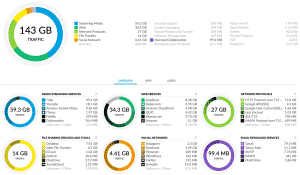Modern computer networks are amazing things. They transport data to hundreds or thousands of computers simultaneously without confusing Mary’s spreadsheets with Robert’s cat videos. They join and separate independent offices and workstations; they deliver all the worlds’ information in the blink of an eye; and, much like the electricity in your house, you hardly think of the network until it’s not working correctly. But unlike the electricity in our houses, computer networks are really really good at remembering the data passing through their wires.
Can the I.T. People See What Sites I’m Visiting At Work?
Let’s get this out of the way. If they’re doing their jobs properly then yes, they can. If you visit Google or CNN or Facebook or your child’s daycare website, the I.T. professionals can see that you visited those sites.  Take a look at this image which is a screen capture from the network dashboard I have running for my home network. You can clearly see that we stream a lot of video from popular sites like Hulu, YouTube, and Amazon Video. In addition, you can tell that we use Dropbox, Gmail, Yahoo Mail, many of the social media sites and that we are an Apple device family.
Take a look at this image which is a screen capture from the network dashboard I have running for my home network. You can clearly see that we stream a lot of video from popular sites like Hulu, YouTube, and Amazon Video. In addition, you can tell that we use Dropbox, Gmail, Yahoo Mail, many of the social media sites and that we are an Apple device family.
None of these things are shocking. If I looked at your home network traffic, I bet it would be similar. What’s shocking is how much data is collected about our movements online…and this is my own personal home network with non-enterprise level gear!
So the I.T. People Can See Everything I’m Doing?
Not exactly… Do you remember a while back (a long while back) when Google switched their search page to be encrypted instead of plain-text? …and now they’re all but requiring websites to do the same? This is kind of good for you. If you look at the light green circle in that image above, it has about 27 GB of traffic that says something like SSL or TLS and you’ll notice that the reporting doesn’t go any further.
So your I.T. team can tell that you visited WebMD, but they (in most cases) cannot tell that you visited https://www.webmd.com/skin-problems-and-treatments/skin-conditions-lice. Typically, the domain you visited (e.g. cnn.com) will be visible in logs but the actual page (e.g. cnn.com/donald-trump-is-a-nightmare/) will not.
That’s not always the case, though. There are software packages and packet inspection techniques that will certainly allow network administrators to look further into your browsing habits. Also, what I’ve said above only pertains to SSL enabled sites–sites with the green lock that say “https” in the browser bar.
Additionally, depending upon what service you use for your personal email and how you have that configured, there may be no security at all enabled there so every one of your love letters to your cat may be exposed for the company to read.
Ugh…So I Don’t Have Any Privacy At Work?
Well first, you shouldn’t be expecting to have privacy at work. Your company pays you to work…not to read up on which movie star was wearing what designer dress to some meaningless gala that no one should care about. Beyond that, you’re probably using their computer and you’re definitely using their network, so they owe you exactly nothing in terms of privacy.
We all know that none of us work 100% of the time we’re in the office, though. No human has that level of concentration. So some amount of downtime is to be expected. Also, there are potentially ways you can get around this bit of snooping your company may or may not be doing.
You could pay for a VPN service. These things are all the rage right now and a simple Google search will turn up 1,000 of them. The VPN service makes it so that all the company sees is the domain portion of the site you visited and nothing beyond that. So they’ll see myawesomevpn.com in the logs but nothing else. Of course, they may get suspicious when all of your computer traffic is passing through that service and block access to it.
Another downside of the VPN is that you may not be able to access any internal services provided by the network. This could be the printer, the network file server, and even your own company email.
Now What?
I wish I had a solution for you. In the end, this is a game of cat & mouse. The workers in the company will try new circumvention techniques and the I.T. people will figure out how to clamp down on them. If you’re in a small to medium sized company, the odds are pretty low that anyone is watching or that anyone cares. If you’re in a big company, just expect to view those gala photos from home outside of work hours. 😉

Leave a Reply